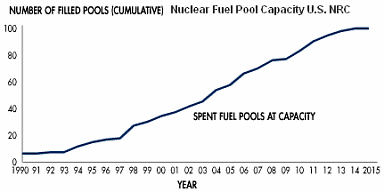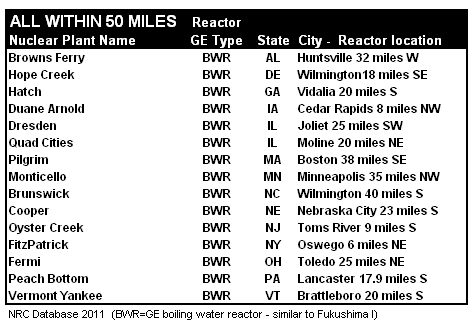| « Aristide Heading Home | President Obama Step In to Protect the Constitutional Rights of Veterans and Citizens » |
Power Corrupts, Nuclear Power Corrupts Absolutely

The Chairman of the United States Nuclear Regulatory Commission (NRC), Gregory Jaczko, told a US House of Representatives subcommittee that: "There is no water in the spent fuel pool [at the Fukushia I plant] and we believe that radiation levels are extremely high, which could possibly impact the ability to take corrective measures." A "utility spokesman" for Tokyo Electric responded quickly claiming that the "condition is stable." AP, March 17
The New York Times, China's Peoples Daily, and other outlets covered this extraordinary asymmetrical exchange between the highest nuclear regulatory official in the US government and a "utility spokesman." (Image)
The public disagreement between two close allies in the midst of a severe crisis is highly instructive on a number of levels. If chair Jaczko wrong, it is a terrible embarrassment for the US. If he's right, we can conclude that much of the information from Tokyo Electric is questionable.
The nuclear disaster at Fukushima I is a complex event. Logical progressions are difficult to grasp and follow, particularly when the United States and Japan disagree so fundamentally at the highest levels.
Concerns about human loss and suffering are paramount. Information on that is also challenging. One theme from the start has been, this is not another Chernobyl. As failures continue and risks become apparent, the comparison to Chernobyl is less important than the risks to the 103 million Japanese on Honshu Island and those in surrounding nations. The best scenario advanced for a major release of toxic elements from the Fukushima I plant involves winds taking the danger west to the Pacific Ocean.
Guenther Oettinger, Commissioner of Energy for the European Union (EU) issued an ominous statement just hours ago:
"The site is effectively out of control," Guenther Oettinger, commissioner for energy, told a European Parliament committee. "In the coming hours there could be further catastrophic events which could pose a threat to the lives of people on the island." Dow Jones, March 20
Ottinger went on to say that information from Japanese government sources was contradictory and that he had an information network beyond just official statements from Tokyo.
When the top US nuclear official and the commissioner of energy for the EU make major hedges on the worsening events in Japan, it's time to take notice.
The Larger Issue
In the midst of all this, it is important to pose the question that may have prevented this disaster and changed the world's energy future. Is nuclear energy an acceptable source of power?
The issue of fuel rod storage combined with the initial regulatory approach to the dangers of nuclear power plants can help answer the question.
The spent fuel pool consists of spent nuclear fuel rods that are stored in the Fukushima reactors (and other GE reactors with a similar design) after they have outlived their usefulness. They're placed in the pool of water designed to maintain the rods in a safe state. The storage needs will exceed capacity in the US by 2015.

ok at the image above of the reactor design at Fukushima (and 23 nuclear reactors in the US) and ask this question. Does this make any sense? The spent fuel rods, pilled up in the fuel pool, are above the reactor vessel and active fuel rods. If there is a meltdown or an explosion of sufficient quantity, toxic elements from both the reactor and the fuel pools may breach the containment structure and enter the atmosphere. Why create a design that compounds the most serious problem, the meltdown, with additional toxic emissions? Don't nuclear regulators understand the concept of a reasonableness test?
Market Drive Regulation
Robert Gillette wrote a classic investigative report for the Los Angeles Times 1979. He described the acceleration of nuclear plant sales and installations and the parallel retreat of regulators. There were no sales of nuclear plants in 1964. By 1966, 63% of new power generation came from nuclear plants. The Atomic Energy Commission (AEC) was swamped with new proposals and short of staff. As larger, more complex reactors were designed, the AEC's budget suffered a series of cuts. Gillette summed it up nicely:
"Larger reactors would … build up larger amounts of radioactive wastes, which if dispersed in an accident, which if dispersed in an accident would amplify the consequences." Robert Gillette, Rapid nuclear growth at root of accident. Los Angeles Times , April 9, 1979
Despite budget cuts, there were farsighted regulators. One of them, Stephen Hanauer, wrote an internal AEC memo in which he suggested that GE was less than serious about it's reported tests of reactors like those at Fukushima I:
"Recently we have reevaluated the GE test results and decided on a more conservative interpretation than has been used by GE all these years (and accepted by us). We now believe that the former interpretation was incorrect, using data from tests not applicable to accident conditions." Stephen J. Hanauer, Atomic Energy Commission New York Times pdf September 20, 1972 (Article)
GE's use of "data from tests not applicable to accident conditions" is the height of reckless cynicism taken to an extreme.
After praising the logic of Hanauer's the suggestion to discontinue the GE reactors with the Mark I design, nuclear energy chief Joseph M. Hendrie suggested that adopting the plan, "could well be the end of nuclear power." He concluded that such an act would generally create more turmoil than I can stand thinking about." Joseph M. Hendrie, 1972 from the New York Times pdf, March 17 (Article)
Myopic Testing - The Past and Right Now
A flawed approach to testing compounded the problems of US nuclear regulators. A 1962 AEC regulation defined testing as the analysis of all credible accidents. Robert van de Poel's analysis showed the following: "What counted as an unacceptable credible accident was defined by a postulated maximum credible accident (MCA) which was laid down in official regulations in 1962. Changing Technologies 1998 van de Poel p.248 If industry scientists and regulators decided that an event couldn't take place, no matter how arbitrary the decision, the nuclear plant's requirement to withstand that event was forgiven.
Safety testing for Fukushima I by Tokyo Electric and Japanese nuclear regulators followed the exclusionary tradition of maximum credible accidents and its successor, probabilistic risk assessment. The credible level of stress on the plant, based on probability analysis, resulted in tests for a 7.9 Richter scale earthquake.
Why? Because that's what the plant could withstand, if you're a bit skeptical and presume that they tested the maximum stress tolerance prior to performing the official test. Why not test it for higher magnitudes on the Richter scale? It is not as though regulators and energy companies had to create a real earthquake for testing. This testing is done with software. Why not extend the effort to a 9.0 on the Richter scale? How hard is that?
They knew that there was a problem in 1972 and did nothing. They know now there are serious problems and they do nothing.
The US government recommended that the Japanese government adopt a 50-mile evacuation radius to around the distressed Fukushima reactors.
That same US government approved nuclear facilities with the similar designs, GE Mark I boiling water reactors. Each reactor or cluster of reactors is within 50 miles of a the population area listed in the chart below.

That same US government recommends boldly pushing forward with more nuclear installations. It says nothing about the obvious dangers based on a history of flawed assumptions, testing, and performance review for the GE reactor type and the entire array of reactors in place.
Is this technology safe? Is it acceptable? Can we trust those in charge to tell us the truth? The answer to each of those questions looks more like no every day.
END
N.B. Nuclear energy firms in the United States questioned the governments suggestion that US citizens observe the suggested 50 mile radius around the Fukushima reactors.
This article may be reproduced entirely or in part with attribution of authorship and a link to this article.


